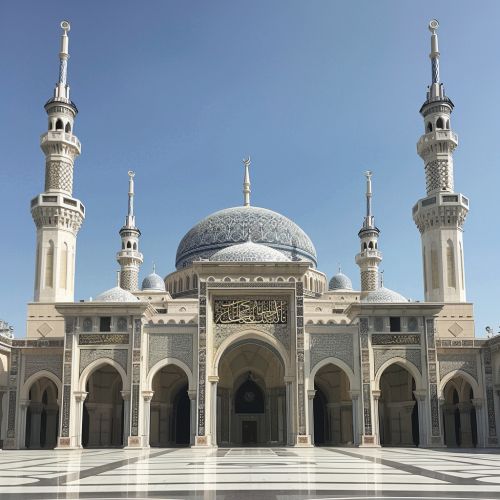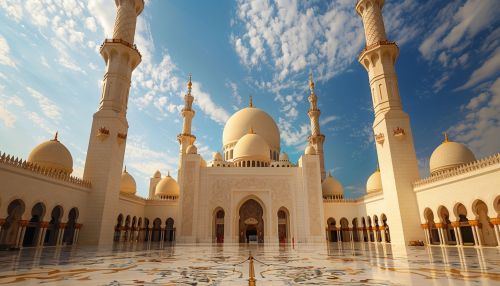Islamic architecture
Origins and Influences
Islamic architecture, a term often used to denote the architectural styles that have developed within Muslim populations over the centuries, has its roots in a number of different influences. These include pre-Islamic Arabian architecture, Roman architecture, Byzantine architecture, and Persian architecturePersian architecture. The amalgamation of these influences, coupled with the unique cultural and religious needs of the Islamic community, gave rise to a distinct architectural style that has left its mark on the world.
Characteristics
Islamic architecture is characterized by several key features. These include the use of geometric and repetitive patterns, known as arabesque, and calligraphy, often used to adorn the walls of Islamic buildings. The use of minarets, domes, and courtyards is also a common feature. The incorporation of natural elements, such as water and gardens, is another characteristic, reflecting the Islamic concept of paradise.


Religious Architecture
Islamic religious architecture primarily includes mosques, madrasas (Islamic schools), and mausoleums. The mosque, in particular, is a central feature of Islamic architecture. It serves as a place of worship, community gathering, and a symbol of Islamic culture and identity. The architectural design of mosques varies greatly depending on the region and period, but common elements include a large prayer hall, a mihrab (niche indicating the direction of Mecca), minarets, and often a courtyard.
Mosques
The mosque is the most common and recognizable form of Islamic architecture. The first mosques were simple structures, but over time they evolved into complex architectural masterpieces. The Great Mosque of CordobaGreat Mosque of Cordoba, the Hagia Sophia in IstanbulHagia Sophia, and the Alhambra in GranadaAlhambra are examples of the grandeur and intricacy that can be achieved in mosque architecture.
Madrasas
Madrasas, or Islamic schools, are another important form of Islamic architecture. These institutions were often built adjacent to or as part of mosques, and their architecture reflects this close association. The layout of a madrasa typically includes a central courtyard surrounded by classrooms and living quarters for students and teachers.
Mausoleums
Mausoleums, or tombs, are another significant aspect of Islamic architecture. These structures were often built to commemorate important figures in Islamic history, such as saints, scholars, and rulers. The Taj MahalTaj Mahal in India is perhaps the most famous example of an Islamic mausoleum.
Secular Architecture
Islamic secular architecture includes a wide range of structures, from palaces and fortresses to public baths and marketplaces. These structures, while not religious in nature, still bear the distinctive characteristics of Islamic architecture, such as the use of geometric patterns, calligraphy, and courtyards.
Palaces
Islamic palaces, such as the Alhambra in Spain and the Topkapi Palace in IstanbulTopkapi Palace, are grand structures that served as the residences of rulers. These palaces often feature extensive gardens, reflecting pools, and intricate tilework.
Fortresses
Fortresses, or castles, were another important aspect of Islamic secular architecture. These structures were built for defensive purposes and often feature high walls, towers, and a central keep. The Citadel of AleppoCitadel of Aleppo in Syria is a notable example of an Islamic fortress.
Modern Islamic Architecture
Modern Islamic architecture continues to evolve, incorporating new materials and technologies while still maintaining the distinctive characteristics of traditional Islamic architecture. Notable examples of modern Islamic architecture include the Faisal Mosque in PakistanFaisal Mosque, the Petronas Towers in MalaysiaPetronas Towers, and the Burj Khalifa in DubaiBurj Khalifa, the tallest building in the world.
